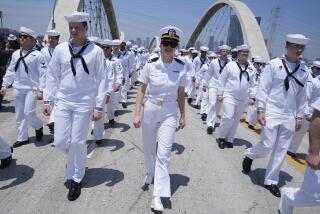Bridge embodies Iraqi unity
- Share via
BAGHDAD — They gathered by the green steel-span bridge, where nearly 1,000 people died three years ago in a stampede set off when rumors spread through a crowd of pilgrims that a suicide bomber was in their midst.
On Tuesday, buoyed by renewed hopes for their country’s future, clerics, politicians and ordinary citizens crossed the Two Imams bridge for the first time since the August 2005 tragedy, restoring the long-severed link between the Sunni Muslim neighborhood of Adhamiya and the Shiite Muslim stronghold of Kadhimiya.
First sealed off in early 2005, the bridge, with blast walls like giant gray tombstones, has served as a symbol of Iraq’s fratricidal religious divisions. The reopening ceremony Tuesday was evidence that the nation’s warfare has abated enough to allow Baghdad to try to work its way back to its pluralistic, multiethnic past.
“There was a saying that if Kadhimiya and Adhamiya united again, then all the Iraqi people will unite also,” said Duraid Nouri Salih, who crossed the bridge Tuesday to visit a friend in Kadhimiya.
“To open the bridge now is clear evidence of security stability, and it is a huge victory and significant achievement,” said Qassim Atta, a spokesman for the Iraqi army in the capital. “We will continue to lift the concrete barriers as we keep moving ahead in many areas of Baghdad.”
For the Iraqi public, question marks remain despite the relative calm of late. Most of Baghdad is still sectioned off by a maze of concrete barricades aimed at separating long-feuding Sunni and Shiite armed groups. Violent acts such as roadside bombings and assassinations are still an everyday occurrence.
On Monday, for example, a triple bombing claimed the lives of 31 people in east Baghdad. Another bombing on Tuesday wounded six.
And then there are the memories, including those of that fateful day in 2005 when the bridge was briefly reopened for pilgrims heading across the Tigris River to a gilded shrine in Kadhimiya to mark the anniversary of the death of a Shiite saint, Imam Musa al Kadhim. After rumors of a bomber sparked panic, hundreds of pilgrims were trampled to death in the stampede or drowned when they jumped off the bridge to escape.
It was the highest death toll in any single incident since well before the 2003 U.S.-led invasion.
After the stampede, Kadhimiya and Adhamiya, with its tomb of the revered Sunni cleric Abu Hanifa, were again closed to each other. During the worst violence, the districts traded mortar fire across the Tigris.
Nonetheless, the hordes flocked to the Two Imams bridge on Tuesday. Sheep were slaughtered in celebration, their blood staining the bridge, and reunited tribal and prayer leaders clasped hands.
Some young men drove in a truck, chanting, “Brothers Sunni and Shiite, we will not sell this country.” Convoys of cars circled the bridge into the night, banging drums. A banner fluttered, with the words “bridge of love.”
Hussein Ali Kadhim, 67, was among those marching to the Shiite neighborhood Tuesday, walking across the bridge two years after he suffered lingering head injuries in a car bombing near Adhamiya’s Abu Hanifa mosque.
“I recall my old days when I was young. My father and also my mother used to walk me to Kadhimiya and we’d take lunch and dinner there, and come back walking at night,” Kadhim said. “It was beautiful, and these were great memories, but the wicked people created this mess.”
On the Kadhimiya side, a 26-year-old furniture seller, who referred to himself as Ghassan, said he had already visited Adhamiya a few weeks earlier and felt safe.
He hoped the government would keep the key transit link open even if there were some attacks between the formerly volatile Sunni and Shiite districts.
“The bad days will not come back again, but still we have to overcome the psychological effect because until now some of my friends feel afraid to go there and consider it a dangerous area,” he said, remembering the days of back-and-forth warfare between Sunni extremists and Shiite militias.
A 60-year-old man who called himself Abdullah thought back to his childhood, when he would cross the bridge to play games in Adhamiya during the holy month of Ramadan.
“I have friends in Adhamiya, and I will visit them in the coming days. Just one of them was visiting me from time to time when the security situation started to be good last year,” he said, clearly missing the old Baghdad. “I was happy when I met him. His eyes were full of tears. I think his eyes will be full of tears when he sees me at his door.”
More to Read
Sign up for Essential California
The most important California stories and recommendations in your inbox every morning.
You may occasionally receive promotional content from the Los Angeles Times.










